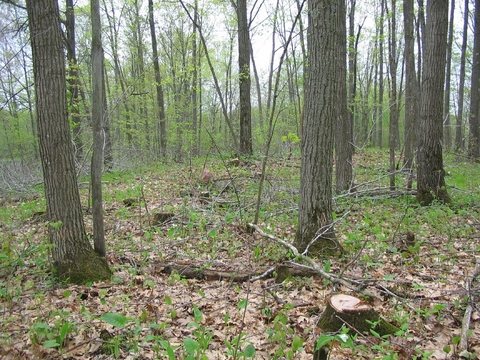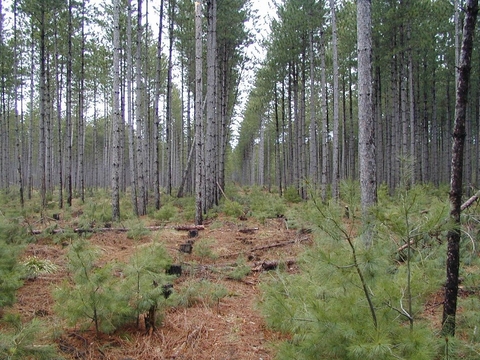Quick facts
Thinning and timber stand improvement improve the vigor and value of existing forest stands. There are many ways to do this.
- Thinning can be pre-commercial or commercial, depending on whether the harvested material is sold.
- Choosing the type of thinning depends on the different characteristics of your woodland.
- Thinning strategies include row, selection, and crop tree thinning.
Choose the right kind of thinning
Choosing the right kind of thinning for your woodland can be complex. Your decision depends on factors such as:
- Site characteristics.
- Stand age.
- Species composition.
- Stand acreage.
- Landowner objectives.
Pre-commercial vs. commercial thinnings
Thinning can be pre-commercial or commercial. In a pre-commercial thinning, harvested material can’t be sold and generally isn’t removed from the site. Woodland managers make pre-commercial thinnings as investments in the stand’s future growth.
On the other hand, commercial thinning yields products that can be sold. Sometimes commercial thinning merely breaks even, covering harvest costs. But in older stands, it can be fairly profitable.
Thinning and woodland stand improvement strategies
Row thinning means removing trees in rows or strips. Row thinnings are mostly conducted in plantations, where trees are planted in rows.
Row thinnings are relatively efficient. They also open up lanes for harvesting equipment to enter and move around within the stand, which may not be possible in unthinned plantation stands.
In most plantations, the first thinning is a row thinning.
Selection thinning involves removing certain trees based on their characteristics, spacing and other considerations. Selection thinning is often used in plantation stands for second or subsequent thinnings.
The advantage of selection thinning is it allows more flexibility than row thinning. Woodland managers can remove low-value trees and focus growth on high-value trees. This strategy improves the stand’s health and long-term value.
You can use selection thinning in hardwood stands, but apply it carefully. Otherwise, it can lead to high-grading. High-grading can damage the stand and severely set back its vigor and long-term value.
Crop tree thinning involves carefully maximizing the growing space available to the stand’s best trees. It’s an excellent approach to use when cutting firewood on your property.
Steps to crop tree thinning
- Walk through your stand, identifying trees with the greatest potential future value.
- These are your crop trees. Mark them with flagging tape, spray paint or some other marker.
- Value doesn’t necessarily mean timber value. You might mark den trees, trees of rare species or any other kind of tree you want to thrive in your woodlot.
- Identify trees that directly compete with crop trees.
- To identify competing trees, don’t look down. Look up at the crowns.
- Any tree with a crown touching the crown of your crop tree is competing with it.
- Remove some or all competing trees.
- Be careful not to overdo it. If your crop trees have been growing under intense competition for years, they could be shocked and stressed if all trees around them are removed at once.
- Consider a multi-stage approach that removes competing trees over a several-year period.
- Monitor crown closure after thinning.
- Repeat these steps as needed.
High-grading harvests only the highest-value trees from a stand and leaves all the rest. This can severely degrade the stand’s health, visual appearance and long-term value.
High-graded stands tend to have suppressed trees of poor form or species. It can take decades for the stand to recover. Diameter-limit cutting—which harvests all trees over a specific diameter—is one common way to high-grade a stand.
A partial harvest may seem preferable to a clear-cut, but in many cases, you would be better off clear-cutting the entire stand. Clear-cutting generally leads to vigorous new growth of an early successional stand. On the other hand, high grading leads to stagnant growth of a low-value stand.
Woodland stand improvement refers to any treatment primarily designed to improve an existing stand’s composition and condition. Stand improvement treatments require a financial investment in the future of the stand.
There are many types of stand improvement treatments. One common approach is to kill or remove undesirable species so desired species have more room to grow. Another is a targeted release of the best young trees in a stand. This approach releases trees by removing competing vegetation.
Reviewed in 2024



